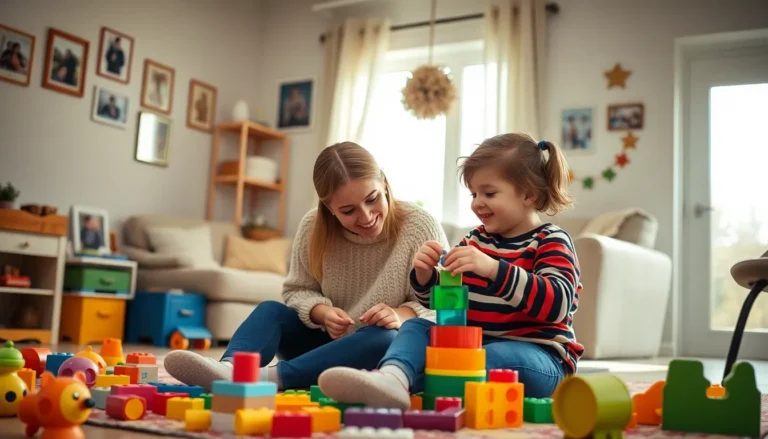Table of Contents
ToggleAdoption isn’t just about finding a forever home; it’s about setting goals that lead to love, laughter, and maybe a few unexpected surprises. Whether it’s a furry friend or a little human, every adoption journey comes with its own set of aspirations. These goals shape the experience, turning it from a simple transaction into a heartwarming adventure that can fill lives with joy and purpose.
Understanding Adoption Goals
Adoption goals encapsulate the aspirations surrounding the adoption journey. These objectives play a vital role in shaping the experience for both the adopter and the adoptee.
Definition of Adoption Goals
Adoption goals refer to the specific objectives that guide the adoption process. These targets might include creating a loving environment for the child or pet, developing strong familial bonds, and ensuring a supportive network. They focus on making the transition smooth and fulfilling for everyone involved. Clarity in these goals enables prospective adopters to align their expectations and actions effectively.
Importance of Setting Adoption Goals
Setting adoption goals establishes a foundation for success during the adoption journey. They provide direction and help assess progress throughout the process. Goals also encourage open communication among family members and support systems. Defining aspirations fosters an understanding of the adoptee’s unique needs and background. When clear goals are present, adopters are more likely to create a nurturing, stable home, ultimately enriching lives.
Types of Adoption Goals

Adoption goals come in two primary forms: short-term goals and long-term goals. Each type plays a vital role in guiding the adoption process effectively.
Short-Term Goals
Short-term goals focus on immediate priorities during the beginning stages of adoption. These goals often include creating a nurturing environment, building rapport, and establishing routines. Adopters might aim to facilitate successful introductions, whether between family members or with existing pets. Additionally, setting communication benchmarks helps address the emotional needs of the adoptee. Tracking early progress ensures a smoother transition for everyone. By creating achievable targets, adopters can foster confidence and stability within the new family dynamic.
Long-Term Goals
Long-term goals establish the framework for a lasting, successful adoption experience. These objectives encompass developing strong familial bonds, ensuring emotional security, and promoting the overall well-being of the adoptee. Adopters often seek to participate in community resources or support groups that reinforce integration. Continuous assessment of progress guides the evolution of relationships and fosters ongoing growth. Creating a sense of belonging and identity within the family unit serves as a cornerstone for the adoptee’s future happiness and success.
Key Factors Influencing Adoption Goals
Adoption goals depend on various factors that shape the experience for both adopters and adoptees. Understanding these influences helps set meaningful objectives.
Individual Motivations
Passion often drives adopters. Their desire for companionship, family growth, or altruism can dictate adoption goals. Personal experiences may also impact motivations, with some reflecting on their upbringing or others seeking to provide a stable home. Goals frequently align with emotional readiness, whether aiming for love or support. Each adopter’s background brings unique insights into what they seek. Clarity in their intentions often leads to nurturing relationships.
Family Dynamics
Family compositions play a pivotal role in adoption goals. Each member’s views can affect the journey, creating a need for open dialogue. Involving children in the process can foster a sense of inclusion, influencing goals toward acceptance and bonding. Spouses may have differing timelines or expectations, necessitating alignment on shared objectives. Solidifying these dynamics enhances commitment to the adoption journey. Ultimately, family unity establishes an environment ripe for love and growth.
Societal Considerations
Societal factors significantly shape adoption goals. Cultural beliefs, attitudes toward adoption, and community support systems contribute to the decision-making process. Local laws and regulations may define requirements or restrictions affecting goals. Awareness of societal stigma can prompt adopters to focus on creating understanding within their communities. Networking with local organizations often provides essential resources, reinforcing supportive structures. Overall, these external influences mold adoption aspirations, driving positive experiences for all involved.
Strategies for Achieving Adoption Goals
Achieving adoption goals requires focused strategies that facilitate positive outcomes for all parties involved. The following methods provide a clear framework for guiding the adoption journey.
Creating a Support Network
Building a support network is crucial for successful adoption. Engaging with family members, friends, and community resources offers emotional backing and practical assistance. Support groups specific to adoption provide shared experiences and valuable insights. Local organizations often host events, fostering connections among adopters and their peers. Involvement in these communities helps to reinforce a sense of belonging and provides ongoing guidance for navigating challenges. Adopters who cultivate strong relationships with supportive individuals enhance their ability to create a nurturing environment. Additionally, these networks offer the necessary resources to address complex situations as they arise.
Establishing Measurable Benchmarks
Establishing clear benchmarks allows adopters to track progress effectively. Setting specific, attainable objectives helps outline expectations throughout the adoption process. Metrics can include milestones such as emotional developments, improved communication, or successful transitions in daily routines. Regularly assessing these benchmarks provides insights into the evolving needs of the adoptee. Adjustments can be made as necessary to ensure alignment with the goals. This structured approach fosters transparency and allows all family members to participate actively in the journey. By recognizing achievements, adopters reinforce a sense of accomplishment, creating a positive atmosphere for growth.
Adoption goals play a vital role in shaping the journey for both adopters and adoptees. By establishing clear objectives, individuals can create a loving environment that fosters emotional security and strong familial bonds. This intentional approach not only enhances the adoption experience but also ensures that everyone’s needs are met throughout the process.
Engaging with community resources and support networks further enriches this journey. It encourages open communication and collaboration, essential for navigating challenges. With a focus on both short-term and long-term goals, adopters can set the stage for a nurturing home that promotes growth and belonging. Ultimately, these aspirations transform adoption into a meaningful adventure that impacts lives positively.




